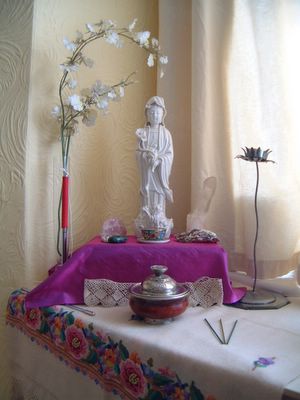Monday, February 27, 2006
Just One Right Attitude of Mind
"I’ve been living with chronic-pain for a long time. It originated from a bad fall and has become worse with time, probably overlapping with the aches and pains that come with age. Lately, physical pain has slowed me down. With being slowed down, I often find myself horizontal, letting my mind drift. At first I criticized myself for doing this, and then, when I didn’t find the will to change, I thought well I’ll just watch my mind drift then.
Lately I’ve been mindful as I mentally drift, which might sound contradictory but, in my experience, it isn’t necessarily a contradiction....."
Tomorrow I plan to go to Elk Island, a local National Park, and I'll take a day off from blogging too. Back on Tuesday.
Sunday, February 26, 2006
Still in the Midst of Conditions
If an essential part of Web 2.0 is harnessing collective intelligence, turning the web into a kind of global brain, the blogosphere is the equivalent of constant mental chatter in the forebrain, the voice we hear in all of our heads. It may not reflect the deep structure of the brain, which is often unconscious, but is instead the equivalent of conscious thought. And as a reflection of conscious thought and attention, the blogosphere has begun to have a powerful effect.
The author goes on to talk about the effect the huge rise in the number of blogs, coupled with tag's defined by 'the people', is having on the structure of the internet. I don't pretend to have my head around this to the extent I could comment about it. So, if you're interested in the goings on behind the scenes of the internet and how its structure is being changed by 'us', then this article is worth taking a look at.
I found it somewhat disturbing when I bumped into the phrase 'constant mental chatter' in connection with blogging! Buddhist Blogger Beware! I ask myself, 'Do I really want to add more to the voice we hear in the forebrain'? I aspire to sit still in the midst of that within myself daily. Partaking of the 'global brain' through blogging is a challenge and, for the moment, it's worth it.
Over the past couple of weeks, since being more involved with other people writing Buddhist weblogs, I've gained a new appreciation of their place in practice. Offered and received in their highest form, the blogs can be understood as an expression of the Sangha Refuge. I know I benefit from sharing the inner workings of others walking The Path. And there is the offering of that which comes from behind the words too.
Saturday, February 25, 2006
In a Contemplative Fashion
He reports: During the last few weeks I have had to drop, one by one, all my plans for the immediate and medium term future as it became clear that I was going to be out of action for some time. Actually, dropping things can be quite a therapeutic activity in itself as I'm sure you know.
And then he went on to say: My other therapeutic activity has been lying in bed listening to Gilbert and Sullivan operas on a personal CD player. "In a contemplative fashion/ and a tranquil frame of mine/ Free from every kind of passion/ some solution let us find. (Gondoliers).
Here is the full verse sung by all:
Gondoliers, Gilbert and Sullivan Act 11
Not half bad ah?
Friday, February 24, 2006
The Grieving Beard
An altar can be where lovable things and unlovable things can go; as offerings. A letter that landed as lead in the heart, books and papers which represent an upset, a shell collected on a walk, a photo of a person in need. Tonight I put some items on the altar, lit some incense and made bows. Tonight I also remember Wayne who took his own life.
It's interesting about Wayne. Jim (not his actual name) had kept Wayne from shooting himself and bailed him out of trouble enumerable times but in the end Wayne could not be stopped, he shot himself. And his good friend stopped shaving, face hairs were neither cut nor trimmed.
About two years latter, for pressing practical reasons, Jim's beard and moustache were shaved off. Their removal brought up strong memories of Wayne. Anger at what he'd done, grief too. Yes, that was a grieving beard and now it is on the altar.
There is nothing that can't be put on the altar of ones heart, or carried until the time is right to shave it off.
Thursday, February 23, 2006
Non-Efficacy of Rites and Rituals
The way I see it, each person enters the corridor of practice carrying what they know. Some enter with a meditation cushion while others enter at the other end, so to speak, with incense stick in hand. Later they may meet and leave, hand in hand, carrying a cushion and incense stick. This has been the way it's been for me, but not necessarily the way for all.
I came across an image of a early Japanese monk, Kuya Shonin, who is depicted with six small figures of Amida Buddha emanating from his mouth representing the six characters of the written Nembutsue chant. Looking at this image it doesn't make sense, you could say "Wow! that's really weird". It's a disturbing image, in the way that one can be 'disturbed' by the Truth. I can't explain it rationally, however when viewing it there's the same sense of being brought up into myself when standing before an altar. Or, as I remember it, when walking in the great shrines in Japan and China I visited last spring.
So, sometime, somewhere, in the middle of a corridor I met myself anew. I'm as happy to bow to the stars and the mountains as at an altar, and I'm so very grateful for the forms that have been handed down and which are part of daily practice. Following them causes me to remember why it is that they are not necessary.
I read a bit about Kuya Shonin, the internet is just so amazing for turning up what one is looking for. His life both as a lay devotee and latter as a monk is impressive.
Wednesday, February 22, 2006
Inner City
Dear Rev. Mugo,
Re your comment that one needs to "trust that doing nothing is worthwhile."
This reminded me that when I was at the Forbidden City in Beijing, our guide pointed out a Buddhist inscription over a doorway that translated as "Do Nothing." I was stunned: in the middle of this vast monument to ambition and activity, a reminder not to strive but just to be.
Here's a thought: one's "old stuff" is one's personal Forbidden City, a seemingly indestructible monument built of ambition, craving, negative thought, etc. Somewhere in the middle of it is the doorway of "Do Nothing."
See you Sunday morning for the retreat,
Gassho
Yep! And the door stands wide open.
Tuesday, February 21, 2006
Singapore Revisited
"How are they"? my friends ask to-day, "Much the same, I'm afraid" is the answer. (I've a tendency towards swollen legs.)
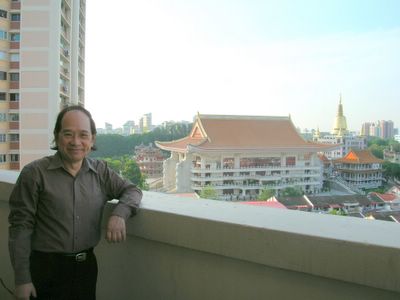
Mr. Lee Coo the architect of Kong Meng San temple (Bright Hill Temple), Singapore.
I knew we were going to visit a temple however Cindy, the days driver, and Mr. Coo had conspired to give me a surprise. We were driving towards a residential block not a temple. My mind was going a mile a minute as we entered a lift, "Is this abduction then"? I asked myself all the while knowing in my heart it couldn't be. Emerging from the lift this is the view we found. "What does it look like"? he asked, "A ship". The ship of the Dharma, a Buddhist Temple. There is so much to say about Bright Hill Temple and Mr. Coo and his incredible kindness, and Cindy's too, however that will have to be another day. I'll pause just a moment to mention that there are four floors, one for each of the Four Noble Truths. And what happens on each floor corresponds to each Truth.

Lee and I on the forth floor of Kong Meng San Temple (Bright Hill Temple).
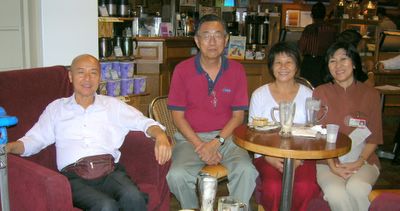
This picture is for Jessie to thank her for her personal support and for all those who made my stay in Singapore possible. I hope we will meet again.
Monday, February 20, 2006
Outside Views
I smile and am slightly shocked because Tom, the editor, speaks of the 'calming and kind quality of the posts'. It's the kind of shock I had last week when somebody referred to me as 'tinny' which is not how I think of myself, although just five foot three! That view, from the outside, does not match with my view from the inside.
That same inner 'shock', comes up for me when I see attention drawn to assessments of ones placing on the path of practice. In the relative world these self evaluations are rarely matched by the view from the outside, and perhaps this is just as it needs to be. Err, just as long as compassion for oneself is in place.
Yesterday Gareth of Green Clouds posted ponderings on issues surrounding being nomination for Blogisattva Awards. Yes, they're kinda fun awards and at the same time the recognition of ones on line offerings by ones peers has a real place, a deep one I feel. Let's see now; there's encouragement to keep going, a natural arising opportunity to honestly look at ones motivations and a call to check-in with the Three Pure Precepts. They translate as: ceasing from doing harm, doing the right thing and being 'good' for others, all admirable intentions one aspires to live up to.
Saturday, February 18, 2006
Brief Encounters
Sometimes that ‘something more important’ really IS more important, you just didn't know why at the time! You know the kind of thing, you inexplicably turn right rather than left taking the longer route home (to start cleaning) and you meet an old friend. One time I was traveling through London transferring from one station to another and bumped into a friend I’d known in India. We had lost touch over time. What a coincidence! Or was it the winds of the Buddha’s benevolent influence that had us outside Victoria train station at the same time, and notice each other. Nothing spooky or fatalistic I assure you just something to do with how life throws up karmic cleaning opportunities: when all conditions are ripe.
Chance encounters such as the one in London are breath taking in the width and depth of what takes place in just a brief encounter, they can be life changing. One meets the deep heart of the old friend and, while knowing love remains, part lighter and brighter accepting that life paths have diverged. Some speck of glue in ones being has dissolved and walking on into ones life, in ways seemingly unconnected with the encounter itself, become obvious and non ‘sticky’. The way is cleared simply because the flow of cause and effect had one in the right place at the right time, you turned right rather than left on the way home. If I remember correctly, it was so long ago, the friend and I had a meal and then I caught a latter train home. So often meals and the like can act as cement and sometimes they can be as water carrying one on freed, unencumbered by the past.
We have a verse that can be recited while washing ones hands: “I wish to cleanse my body and my heart”. There it is, intention together with action, a great reminder in the rush of the day.
Now, having got that whole thing out of my mind and onto paper, onward to the vacuum cleaner.
Animal Friends
This is probably not a cat. It was found in the corner of a painting sent along with the information below and thought it worth an airing anyway.
Rev. Mugo,
Here are a couple of references to the cat in the depictions of the Buddha's Parinirvana. See the book "Zen & Japanese Culture" by D.T. Suzuki for a story about a monk called Cho Densu (1352-1431) who was commissioned to paint the Buddha's PariNirvana for the Tofukuji Zen monastery at Kyoto (39 by 26 feet). The story goes that a cat would watch him paint the picture. Any way the artist wanted ultramarine in mineral form to paint with. The cat disappeared then returned to show him where he could get it from, so the cat was included in the picture!
I think traditionally only the animals of the Chinese zodiac, rat, ox, dog, monkey.... etc. were included because it was thought that they came to pay their last respects to the dying Buddha, but the cat being proud and self-satisfied didn't come (see the book "The Cat Who Went to Heaven" by Elizabeth Coatsworth)!
In Gassho,
I know this will not change lives however if you want to read alternate reasons why the cat is not one of the zodiac animals go here and scroll down to 'Origin Stories'.
Hell will no doubt rain down upon me for mentioning that cats might possibly exhibit pride etc. Sometimes we get so close to our animal friends we believe they are us; that's human. One summer, when a novice, I took care of a dog; I held her tight through thunder storms, shampooed and cream rinsed her, combed her pantaloons to perfection, cooked special food for her and her cat companion. Then one day she bent her beautiful head and gulped down some poop! We were, at once, 'one' and very very different.
Pushka and Max, my late shadows and dear friends.
Thursday, February 16, 2006
Ancient Sight
The Last Invocation
AT the last, tenderly,
From the walls of the powerful, fortress'd house,
From the clasp of the knitted locks from the keep of the well-closed doors,
Let me be wafted.
Let me glide noiselessly forth;
With the key of softness unlock the locks--with a whisper,
Set ope the doors, O Soul!
Tenderly--be not impatient!
(Strong is your hold, O mortal flesh!
Strong is your hold, O love.)
Walt Whitman (1819-1892)
A young Buddhist of my acquaintance in Montana sang The Last Invocation at a small family memorial for her grandmother. It was breath taking to hear her sing and I can still hear it in my minds ear.
Stonehenge has the best of grandmothers in its presence in the folds of Wiltshire, England. Always there to call upon, never dies, comforting in its enduring. If you pass by this ancient site do pause for a moment.
*The photograph was taken by one of the monks of our Order. With Nine Bows, thank you.
Tour of Buddha Relics
When I was in Taiwan in May a world tour of Buddha's relics had recently been there. They had been successively enshrined in a number of temples during the celebrations called Wesak. (This marks the start of the Buddhist new year during which the Buddha's Birth is celebrated). By all accounts this was a huge event with thousands of people walking past and paying their respects.
In July, back in the UK, I was taken to see some Relics in a temple in Birmingham. In a posting on July 15th I ponder on the issue of authenticity of such relics. Like the ones in the news item these were quite low key in their public presence yet non the less 'present' in an intangible sense.
Wednesday, February 15, 2006
Arctic Vortex
Arctic Vortex
This winter has been the mildest since 1930 something, with hardly any snow and hardly any seriously cold temperatures. But that is all about to change, for one day! The drop in temperature is due to the Arctic Vortex which is pushing cold air at Alberta. Tonight's TV weather forecast shows an impressive mass of cold air spinning down from the top right of the screen bulging down to bottom left. We could have a high of -19 c on Thursday and then on Friday -2 c and Saturday -1 c. You can watch an animation of the Artic Vortex here.
Just because I wanted to end the day with something other than a spinning mass of air I offer this from the Denkoroku.
This poem appears at the end of the chapter on Nagyaarajyuna, the fourteenth ancestor after Shakyamuni Buddha.ITS solitary light, wondrously vast,
is never darkened
For the wish-fulfilling MANI-JEWEL
shines forth illumining everywhere.
Tuesday, February 14, 2006
Refraining from Avoidance
Our conversation stimulated memories of dentists past. A Buddhist dentist whose assistant, also a Buddhist, tried to convince me not to have Novocaine. "It's only pain, it will pass"! Teaching I was not ready to hear right then. And the Irish dentist, with a jewel set into his front tooth. In his care, while deep in the horror of a wisdom tooth extraction I heard, "everybody's got to hurt, some times" coming from the sound system. It was such corny good timing, I had to restrain from laughing out loud. One can't plan for those moments.
It's natural enough to want to avoid pain, to be put out of ones misery. After that extraction I suffered the worst pain of my life. I remember thinking a deliberate blow to the head could not come too soon. It was that bad and pain killers had already failed me. Years latter I was told that "strong men" faint from having a 'dry socket' which is what I, unknowingly, was suffering from.
Physical extremity can be a great teacher simply because there is no getting away from it. Dental pain, so close to ones brain, seems to crush all reasoning power too. I eventually took stock, canceled a trip to the monastery and spent a week at our Hermitage in Wales. I had decided I'd just have to 'sit it out' and soon after that decision the pain started to subside; or was it the fear that subsided?
Monday, February 13, 2006
At the Buddha's Death
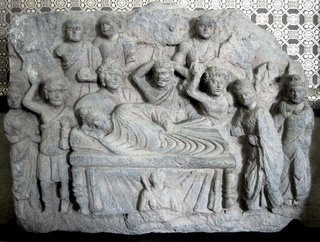 The Buddha's Parinirvana.
The Buddha's Parinirvana.
A carving from Gandhara, 2-3rd century.
Image recently released into the public domain.
I seem to be a bit wistful this evening, perhaps it's contemplating death that's done it. When in the presence of somebody who has recently died, when the body has ceased to have physical life, there remains a sense of vibrant 'life' that is unmistakable. At once there is both sadness and a great sense of celebration. In images of the Buddha's Parinirvana my Master would point out the person who is depicted crying. Reminding us that we have feelings and it is OK to be seen to grieve. If I remember rightly, along with the grieving disciple she would point out the sleeping cat! Anybody remember Rev. Master talking about the cat?
Go here if you want to read a translation of the Mahaparinivana Sutra, The Great Discourse on the Total Unbinding by Thanissaro Bhikkhu.
Sunday, February 12, 2006
Close Up
I'd forgotten about this encounter with a penguin. It was one of those moments of intimacy that can't be explained or adequately described. Life is full of them, when you notice.
Thanks to Iain Robinson for the photograph.
Saturday, February 11, 2006
Rise Up

There is a natural longing to reach into the limitless blue sky, to rise up. Everybody, no matter how burdened at present, will know what I am talking about here. It is part of our make up and what causes beings to ask fundamental questions like, "who am I"? "what's life for"? Children ask, teens ask, adults ask and sometimes an answer is heard. What makes the difference is the readiness to listen.
Adoration to all the Buddhas,
Adoration to the limitless Teaching,
Peace! Speak! Blaze! Up! Open!
To the glorious peaceful One,
For whom there is no disaster.
Hail! Hail! Hail!
I silently recite this verse when danger is imminent, for example when taking off or landing in a 'plane. As the engines roar, the rivets pop and oblivion seems inevitable, 'prayers is what you got left'.
For those who are taking to the skies in the next few days, have a good and safe flight.
Thursday, February 09, 2006
Driving with Dignity
Dear Rev. Master Mugo,
The whole "driving as walking meditation" came up this morning, as a result of the recurring situation in city traffic of finding myself at a stoplight. I find long distance driving good meditation - especially in a vehicle with cruise control. The relaxed alertness you described is quite familiar since I do a lot of long trips. Driving in the city is problematic for me, though.
What I was referring to (in our conversation of yesterday) was learning to deal with the competitive tension I fall into at traffic lights. I have a lot of trouble with red lights. It's to the point (in my efforts to refrain from racing away from lights) that if I'm coming up to an intersection where one lane is empty and the other lane has a car in it, I'll switch lanes, if necessary, to avoid being in front at the "start line".
I don't know how I always seem to end up there on the start line. It certainly seems like it happens more often than pure random chance. It happened again first thing this morning - at the first light I got to on the way to work. This time, though, I had just been mulling over the walking meditation at our last retreat.
You had mentioned the idea that walking meditation could be translated as "walking with dignity". Sitting at the stoplight, with the sports car in the lane beside me, it occurred to me that it might just be possible to treat driving the same way. A slightly different position of the hands (from walking to driving) perhaps, but the same "dignity", focus and awareness.
The light turned green, and I drove away, trying to start off as I would my first step in a period of walking meditation. It worked pretty well. Perhaps it was my imagination, but the driver beside me seemed pretty relaxed too.
I've tried lots of ways of dealing with red lights. One senior monks approach, of just being willing to be in and observe the situation almost works. It's a pretty slippery slope though - one quick impulse and I'm racing away from the light. I still don't know what I'm afraid of "losing" or what I think I'm "gaining", but it's that kind of thing. At some point I hope I'll recognize it, but meantime I'm going to work on my walking meditation, both in the zendo and while driving.
With bows,
Thanks! Thank you SO much for this. Driving with dignity; I will remember that when I next get behind the wheel. Mugo
Wednesday, February 08, 2006
March of Time
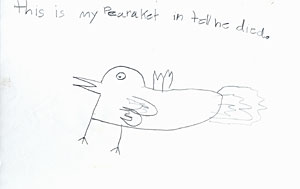
Drawing and text just had to be seen by more people. It was found here to-day by a loyal reader, thank you. It will be gone tomorrow though!
My first 'loved one' to die was Joe, a parakeet, and I would not have been able to spell that either! A child's first encounter with impermanence is often through the death of a close critter. Perhaps this is one of the good reasons for children to have 'pets' to take care of? I love how this child can mix up time and come up with a good image in the present past...
Finally here is a link to a thoughtful posting on the inevitable march of time.
Tuesday, February 07, 2006
Compassionate Fish
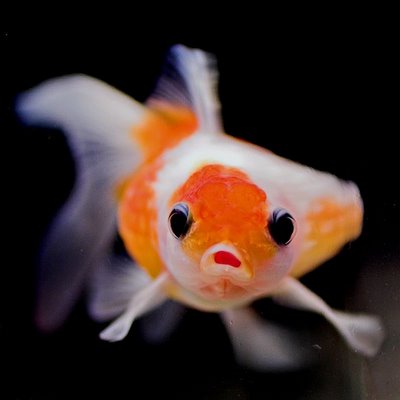 More good photographs like this one from Gly Young, Richmond BC, Canada.
More good photographs like this one from Gly Young, Richmond BC, Canada. Hi Rev. Master Mugo,
I seem to be doing pretty well. Thanks for your last email and your comments about transferring merit. They were helpful. I guess I don't think about transferring merit too much (maybe I should). The kids come back soon, and I'm just about ready for them. I've had a chance to do some deep cleaning and clearing out, and it feels better around here.
The fish story was kind of interesting to me. It happened just before school was out for the holidays last December. One of the 2-yr.-old siblings of one of my kids poured a full can of fish food into the tank. The can was a little bigger than a coke can. I'll spare you the story of getting new filtered water, cleaning and re-filling the tank at 11:00pm. But by the time I got the three fish back into the clean water they were all deeply gasping for air. The two white ones recovered after about 30 min., but the big orange one was still lying on his side gasping and starting to curl up. As healthy fish they would frequently chase each other around the tank, and I wasn't sure if they particularly liked each other, or how they viewed each other. But this night I watched and sat with them for about two hours and they kind of amazed me. The two white ones, who had already recovered, got on both sides of the orange one and held him upright and stayed with him, holding him for about 30 to 45 minutes. They never left him, until suddenly he seemed to have caught his breath and he took off. I was really happy for them and have felt a lot closer to them since we went through that night together.
Even though they "seemed" to be pretty independent from each other during their everyday life, when the chips were down they pulled together. Come to think of it, maybe that's kind of like transferring merit. Don't know for sure.
Take care. In gassho,
Collective Dis-ease
A company in Germany, reported on the BBC News, has adopted a radical approach to habitual complaining among its staff. It’s become a sackable offence! At first this might seem like an uncompassionate approach however on closer examination, maybe not. Just one person, a chronic complainer, had to be let go and the instruction for people who wake up on the wrong side of the bed is: “stay at home”! Apparently the company and staff are flourishing within the positive climate this change of policy has brought about.
There is a Dharma Talk by Rev. Master Koshin on the North Cascades Buddhist Priory web site that you might want to listen to.
Monday, February 06, 2006
'March of the Penguins'
I've just been watching the film, 'March of the Penguins' and everything about the Emperor Penguin is educational, and they are entertaining too. The life of these amazing creatures is geared around; staying alive on Artic ice, surviving harsh conditions as a community, hatching their eggs and then getting everybody back to open water again. Once the chicks are big and bold enough to swim, the parents leave!
I particularly liked how they have adapted their social habits to keep warm out there on the Artic ice.
To better fight against the cold of the Austral winter, the emperor penguins
have adopted social behavior patterns which allow them to save a lot of energy. The most striking adaptation is the huddle formation in which the individuals huddle against each other and form a very dense group. Only their backs are exposed to the wind, and they take turns so that the ones at the edge of the huddle formation gradually move towards the center where they will be more protected for a while, until they find themselves out on the edge again.
Text from the Warner Brothers official web site.
If there is a child in the house, or if there is not, you might want to go and test your ability to Save the Egg.
Native American wisdom has it that we humans can learn from the ways of creatures.
Sunday, February 05, 2006
Kitchen Clean-up
 For breakfast I eat oatmeal, otherwise know as porridge by the European/Briton. When somebody pointed me to her Flickr on line photo album and this photo I became curious. Well I just had to give Optimum Zen a try! It is an OK cereal and I eat it as a special treat on Sunday. I'm a creature of habit though and am glad to be back to the oatmeal/porridge on Monday. It's made and distributed in Canada so all of you out there in Japan, Sweden, Britain, U.S.A., Spain, Australia, Ireland, Germany, Bulgaria, South America and Lithuania; sorry. And for those of you who have a dishwasher, this is how they really work!
For breakfast I eat oatmeal, otherwise know as porridge by the European/Briton. When somebody pointed me to her Flickr on line photo album and this photo I became curious. Well I just had to give Optimum Zen a try! It is an OK cereal and I eat it as a special treat on Sunday. I'm a creature of habit though and am glad to be back to the oatmeal/porridge on Monday. It's made and distributed in Canada so all of you out there in Japan, Sweden, Britain, U.S.A., Spain, Australia, Ireland, Germany, Bulgaria, South America and Lithuania; sorry. And for those of you who have a dishwasher, this is how they really work!Anybody, lay or monastic, who has spent time in one of our monasteries or a priory will know about 'kitchen clean-up'. It is perhaps the major communal activity of the day, apart from formal meditation, and a powerful training ground for mindfulness and patience. The memory of my mischievously passing a wet mop over bare sandled feet just came to mind! Playfulness is part of practice too.
Many thanks for these two photographs. I know who sent the second one, the original source is unknown to me.
Saturday, February 04, 2006
One Jewel
Dear Friend,
What the Reverend Master Daizui says is true. And I can see how it 'flipped your pancake', (love that expression). Yes, one answer is to simply keep sitting and continue to simply let go, especially all ideas about how to meditate and what that might be! Yes, the awareness of the person making effort will arise, simply sit within the center of that. What or who is it that is making the effort? You can ask that question of yourself and then sit and listen, inwardly! My suggestion is to: keep on just sitting and then, if it seems good, feel free to talk/write to me as the practice grows on you. We call that 'checking in'. Right away I'd use the words 'just sit' rather than meditate.
The line from Rev. Master Daizui's book; "when people are meditating they don't even know that they are doing it." is a very positive one in actual fact. Many people, all people, unknowingly know about meditating, some seem to be naturally more reflective than others though. So it is after all not something one does, like cooking a meal, more something one IS, unknowingly. It is our inheritance to be and live 'one and undivided'. Meditation and practice throws up, from the first moment of doing formal zazen, ones habits. They are termed in Buddhism the 'three poisons'. They are, desire, its frustrated form felt as anger/frustration and delusion. None a problem in themselves.
Thanks for taking a look at the book, I'll probably order a box of them. The pancake trick is what we call "being disturbed by the Truth", a good disturbance by the way!
Keep going; the Jewel is in the palm of your hand.
With Bows,
Thanks for this, Reverend Mugo.
I had sort of forgotten that essential notion of "just sitting." The idea was starting to creep into my practice that I had to be doing something constructive, that there had to be definite, measurable improvement each time or it wasn't working. That's how I approach most things. But not writing, interestingly enough. Each time I sit down to write, I try to be a beginner. I try to forget what I know about good writing, and rediscover it anew by writing. Probably that's a good spirit to bring to just sitting.
There's more I wanted to say, but the family calls. Talk to you soon, and thanks for the talk. And the blog!
And thank you!
Thursday, February 02, 2006
Triple Gem
Dear Rev. Mugo,
I hope you are well. I've been reading Rev. MacPhillamy's book. I like its relaxed, conversational style. The lack of terms from other languages is also refreshing and offers a less "exotic" approach to the subject, which is a good thing. The ancient, Asian terminology that most Buddhist books use can make it seem that you should be having an ancient, Asian experience to really practice meditation, whatever that might mean!
I'm part way through the book, and I've come across something that really tripped me up. On page 66, the Reverend writes: "Meditation cannot be easily judged or measured---which is probably just as well, since measuring and judging are precisely some of the things which right thought teaches us to set aside. As a matter of fact, when people are meditating they don't even know that they are doing it. That sounds strange, but the reason is actually very simple: if a person were to know that he or she was doing it, then part of the person would be doing it and another part would be knowing that it's being done. This would create a division in a mind that, by its very essence, is one and undivided."
The specific line that flipped my pancake was "when people are meditating they don't even know that they are doing it." That seems to go against the whole notion of being alert, focused, and present in the moment. How can one be aware of meditating and yet not know that one is doing it?
I guess part of the problem is that I'm trying to understand this from the "outside," with the measuring and judging mind. Maybe the best thing is to keep meditating, keep practicing, and not be hung up over the contradiction. Or what seems like a contradiction.
What do you think?
I'll post my answer tomorrow. This letter is a fine example of what we call in Buddhism; Going for Refuge: Taking Refuge in the Dharma (reading the book), Taking Refuge in the Sangha (asking me a question) and clearly the author is Taking Refuge in the Buddha (practicing seated meditation). The Three Refuges are sometimes referred to as the 'Triple Gem'. It's value is immeasurable.
Wednesday, February 01, 2006
Cause and Effect
There are three time period during which one reaps the consequences of ones actions. Simply put; immediately, latter and much latter! Immediate? - felt very very sleepy and concluded I was tired. Latter? - felt tired and hungover'. Much Latter? - there is no knowing how long the time period extends for reaping consequences. However in the near future I'll be eating leftover snacking food in smaller bites, over a longer time period!
The definition of a 'hangover' is: 'The disagreeable aftereffects from the use of drugs (especially alcohol)'. In my case; no drugs, no alcohol just food in excess eaten with good intentions yet tainted with a whiff of ignorance. However wonderful 'it' may be in the moment, ignorance is not bliss long term.
And for the adventurous Star Trek, The Next Generation did an episode called Cause and Effect. In it they determine that they are caught in a causality time loop, and spend the rest of the episode devising a plan to escape it. Not a million miles away from here, but don't pick that one up and run with it too far. Please!
Blind Eye
I have been borrowing videos from the local library and particularly enjoy watching Derek Jacobi as Brother Cadfael in the BBC drama series of Ellis Peters' murder mystery books. Cadfael is full of wisdom, love and compassion. Here he is:
"A blind eye is the easiest thing in the world to turn on whatever is troublesome".I've just finished watching "The Pilgrim of Hate" which spoke of 'penance'. Self-punishment in order to atone for a wrongdoing is the antithesis of how mistakes are dealt with in Buddhist practice. In The Pilgrim of Hate, Brother Cadfael is characteristically compassionate and understanding in the uncovering of the lies, greeds and religious fervor that obscure the truth.
From "Monk's Hood", more Brother Cadfael quotes here.
I just ran the spell checker and the choices are: - Replace, Replace All, Ignore, Ignore All and Learn.
Made a mistake? First acknowledge it and then choose the 'learn' button.
